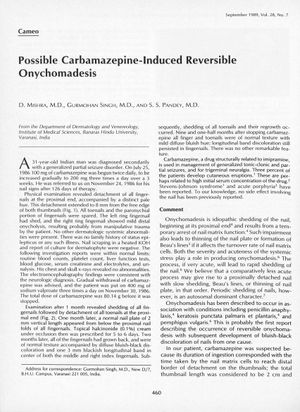Possible Carbamazepine-Induced Reversible Onychomadesis
September 1989
in “
International Journal of Dermatology
”

TLDR Carbamazepine may cause reversible nail detachment.
The document reports a case of a 31-year-old Indian man who developed onychomadesis, a condition characterized by the detachment of nails from the nail bed, after taking carbamazepine for a seizure disorder. The patient began treatment with 100 mg of carbamazepine twice daily, which was increased to 200 mg three times a day over three weeks. After 126 days of therapy, he exhibited detachment of all fingernails at the proximal end and a distinct pale hue. No other systemic abnormalities were present, and various tests including blood counts, liver function, and x-rays were normal. Upon discontinuing carbamazepine and switching to sodium valproate, the patient's nails began to regrow. After nine and a half months, all nails were of normal texture, although some discoloration persisted. This case suggests that carbamazepine may cause reversible onychomadesis, with the authors noting that no such side effect involving nails had been previously reported. The exact mechanism by which carbamazepine induced onychomadesis is unclear, but it is postulated to involve an arrest of nail matrix function due to the drug or its metabolites.





